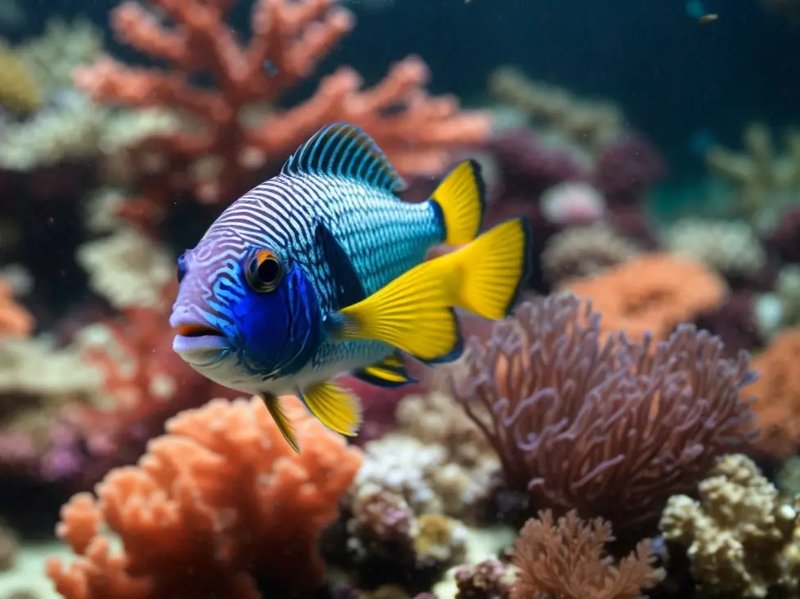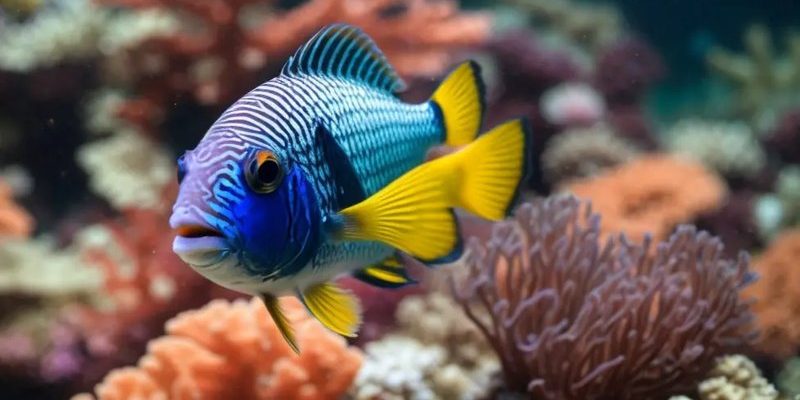
It’s a bit like preparing a cozy home: you wouldn’t just throw some furniture in a room and hope for the best, right? Similarly, damselfish need specific tank requirements to thrive. This guide will walk you through the essentials—size, salinity, and temperature—so you can set the stage for a happy, healthy fish family. Let’s get into it!
Understanding Tank Size for Damsel Fish
When choosing a tank for your damselfish, size really matters. Ideally, a tank should be at least 30 gallons if you want to house multiple damsels. Though these fish are small—growing to about 2-4 inches—they can be quite territorial, especially when they start to establish their space.
A larger tank gives them room to swim and explore without feeling cramped. Imagine living in a small studio apartment; you might feel a bit boxed in. But a spacious, well-decorated home feels like a paradise. In a big tank, damsels can also set up their territories without constantly bumping heads with each other, which can lead to stress or injury.
If you’re going smaller, say a 10-gallon tank, it’s better for just one or two damsels. This way, you can keep the peace. Remember, fewer fish means less competition for resources like food and hiding spots. Ensuring that your fish have enough space will go a long way in keeping them healthy and happy.
Salinity Levels: Creating the Right Environment
Now, let’s talk about salinity, which is crucial for any marine fish, including damsels. These fish come from saltwater environments, so you need to mimic that in your tank. The ideal salinity level for damselfish is between 1.020 and 1.025 specific gravity.
You might be wondering how to measure this. A handy tool called a hydrometer can help with that. It’s like a thermometer for salt levels, and it’ll tell you if your tank needs a bit more salt or if you’re good to go. Honestly, keeping an eye on salinity is crucial. If levels are off, your fish can become stressed or even sick.
To adjust the salinity, you can mix marine salt with fresh water until you reach the desired level. Just be careful not to change it too quickly; sudden shifts can throw your fish into a tailspin. It’s all about keeping things stable and comfortable, so your damsels can thrive.
Temperature: Finding the Sweet Spot
Temperature is another key factor to consider for your damsel fish. They thrive in a range of 75 to 82 degrees Fahrenheit. This is just about the same temperature you’d want for a cozy swimming pool—warm enough to enjoy, but not so hot that it feels uncomfortable.
To maintain this temperature, you’ll want a reliable heater. Think of it as setting the thermostat in your home. You wouldn’t want it to be too hot or too cold, and your fish feel the same way. A thermometer will also be your best friend here, helping you keep track of any fluctuations throughout the day.
It’s important to remember that sudden temperature changes can be harmful. Just like we wouldn’t want to jump from a hot shower into a freezing cold pool, your fish need smooth transitions. Make adjustments gradually, and they’ll thank you with their lively swimming.
Filtration and Water Quality
Aside from size, salinity, and temperature, water quality is vital for damsel fish. A good filtration system helps keep the water clean and free from harmful toxins. You’ll want a filter that provides both mechanical and biological filtration.
Mechanical filtration traps debris and particles, ensuring your water is visually clean. Biological filtration, on the other hand, supports beneficial bacteria that break down harmful waste. It’s like having a little ecosystem working hard to keep your fish happy.
Regular testing of water parameters—like ammonia, nitrites, and nitrates—is essential. You’ll want ammonia and nitrites to be at 0 ppm and nitrates below 20 ppm. Using a test kit will help you stay on top of things. Think of it as giving your fish a check-up to ensure everything is healthy.
Decor and Hiding Spaces
Damsels are curious little creatures that love to explore. Having decorations like rocks, coral, or artificial plants not only creates an attractive environment but also provides hiding spots. This is especially important since damsels can be territorial.
When arranging decor, think of a natural reef setting. Create caves or crevices where fish can hide when they feel threatened or just want a moment of peace. Your damsels will appreciate these spaces, and they’ll feel less inclined to become aggressive toward one another.
Additionally, ensure any decorations are safe for saltwater tanks. Avoid anything sharp or toxic that could harm your fish. A little creativity in arranging their environment can go a long way in keeping them engaged and stress-free.
Feeding Your Damsel Fish
Now that you’ve set up their home, let’s talk about feeding. Damsel fish are omnivores, which means they enjoy a variety of foods. A balanced diet includes high-quality flakes, pellets, and frozen or live foods like brine shrimp and mysis shrimp.
Feeding them a mix not only keeps them interested but also meets their nutritional needs. Think of it like meal prepping for your fish: variety is key. You wouldn’t want to eat the same meal day in and day out, right?
Feed them small amounts two to three times a day, and ensure they consume everything within a few minutes. Any uneaten food can foul the water, which isn’t good for your tank’s health. It’s all about creating a balanced diet to keep your damsels vibrant and active.
Preventing Common Issues
As with any pet, ensuring the health of your damsel fish involves regular maintenance and awareness of common issues. One common problem is aggression among damsels, especially if they’re not given enough space. If you notice one fish picking on another, it might be time to rearrange the tank or consider housing only calmer species.
Another area to watch is disease. Keeping a close eye on your fish for signs of illness—like changes in behavior, appetite, or appearance—can help catch issues early. Having a quarantine tank can also be beneficial for new arrivals to prevent introducing disease to your established fish.
Regular water changes, maintaining clean equipment, and ensuring your fish are well-fed will create a happy, healthy environment. Remember, you’re not just a caretaker; you’re creating a thriving underwater community.
In conclusion, setting up a tank for your damsel fish involves some important considerations: size, salinity, and temperature. By providing them with the right environment, you’ll ensure these little gems can thrive and bring joy to your marine world. So roll up your sleeves, get prepared, and enjoy the vibrant life that these fish will bring to your aquarium!

